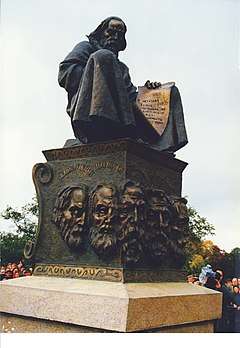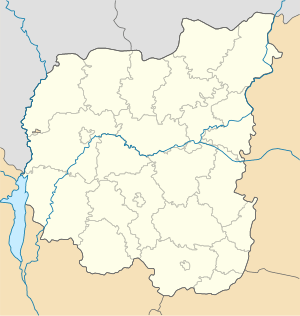Liubech
Liubech (Ukrainian: Любеч, Polish: Lubecz) is a small ancient town (first mentioned in 882) connected with many important events since the times of Kievan Rus'. It is located in Ripky Raion, in Chernihiv Oblast (province) of northern Ukraine. Liubech is 250 kilometers (160 mi) north of the capital of Ukraine, Kiev, and located near the Belarusian border. Population: 2,027 (2019 est.)[1]

Liubech Любеч Lubecz | |
|---|---|
Town | |
 Flag  Coat of arms | |
 Liubech Location of Liubech in Ukraine  Liubech Liubech (Ukraine) | |
| Coordinates: 51°42′18.8″N 30°39′42″E | |
| Country | |
| Oblast | |
| Raion | Ripky Raion |
| Area | |
| • Total | 6 km2 (2 sq mi) |
| Population (January 1, 2019) | |
| • Total | 2,027 (2,019 est.)[1] |
History
In 1018 there was a great battle between the army of the Grand Prince of Kiev Sviatopolk the Accursed and the Prince of Novgorod Yaroslav the Wise who was rushing to seize power in the whole Rus'. In 1097 the Council of Liubech, also known as the Congress of Rus' Princes, was held here. It was initiated by Vladimir II Monomakh and divided the land of the Kievan Rus' between the princes.
In the 14th century, Liubech became part of the Grand Duchy of Lithuania. In 1632, Polish King Sigismund III Vasa granted Lubecz city rights. It was a royal city of Poland. From 1635 to 1667 it was part of the Chernihiv Voivodeship of the Lesser Poland Province of the Polish Crown.
St. Anthony of the Caves (Anthony of Kiev) also known as Antony Pechersky, was born in Liubech in 983. He established the first Ukrainian monastery known now as Kiev Pechersk Lavra, and is considered to be the father of East Slavic monasticism.[2]
References
- Любеч and article in Brockhaus and Efron Encyclopedic Dictionary
- "Чисельність наявного населення України (Actual population of Ukraine)" (PDF) (in Ukrainian). State Statistics Service of Ukraine. Retrieved 23 May 2020.
- Delaney, John (2005). Dictionary of saints. Random House, Inc. p. 702.